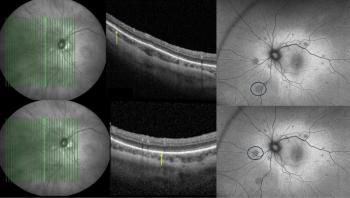
Glaucoma monitoring implant receives CE mark
An implantable glaucoma sensor has received CE mark approval for marketing in the European Union. The sensor (Eyemate, Implandata Ophthalmic Products) can provide frequent IOP readings, informing patients and their physicians about how the pressure changes by time of day and from one day to another.
An implantable glaucoma sensor has received CE mark approval for marketing in the European Union.
The sensor (Eyemate, Implandata Ophthalmic Products) can provide frequent IOP readings, informing patients and their physicians about how the pressure changes by time of day and from one day to another.
Professor Hagen Thieme of Otto-von-Guericke University Magdeburg in Germany led the pivotal ARGOS-02 trial used to obtain CE mark certification. Implandata spokesperson Max Ostermeier declined to disclose results of that trial pending publication, but noted that Implandata had redesigned the implant based on results of the pilot ARGOS-01 study.
For that study, the ring-shaped sensor consisted of eight pressure-sensitive capacitors in a single application-specific integrated circuit combined with a circular microcoil antenna, all encapsulated in silicone.
The device measured 11.2 mm in diameter and 0.9 mm in thickness. A hand-held device transmitted energy to the sensor telemetrically and received and stored its data. The Global System for Mobile communication module allowed transfer of the data to a database that physicians could access online.
The company, based in Hannover, Germany, is developing a smart ‘phone application allowing the patient to track this data and communicate with the physician.
The device offers advantages over current methods for IOP monitoring, according to Implandata. Because conventional monitoring requires visits to the offices of trained healthcare workers, these measurements are obtained just a few times each year, even though IOP may fluctuate throughout the day.
Measuring IOP throughout the day, every day, could allow patients and their physicians to tailor glaucoma medications to the patients’ specific needs, Implandata said.
"Twenty-four hour monitoring of intraocular pressure with an implantable sensor is transformative for management of glaucoma patients as it provides a plethora of data and deeper insight for enhanced management of their disease,” said Implandata’s Scientific Advisor Dr Robert N Weinreb, director of the Shiley Eye Institute of the University of California, San Diego, in the press release.
The newly designed implant avoids adverse events seen with the ARGOS-1 trial, Ostermeier said.
ARGOS-1 issues
In ARGOS-1, researchers implanted the sensor in six patients with cataracts and primary open-angle glaucoma. In each patient, they placed the sensor in the ciliary sulcus through a 5.5-mm corneal incision after intracapsular lens implantation at the end of cataract surgery.
Patients were able to use the device to measure IOP, and these measurements showed similar profiles to those of Goldmann applanation tonometry (GAT).
However, a significant pigment dispersion occurred during the implantation in three patients, and in the first few days after implantation, four patients developed significant sterile anterior chamber inflammation. Two of these four patients showed a hypopyon of 1.5 mm.
Neither patient showed signs of posterior segment involvement, and anterior chamber probes revealed no bacteria.
Nevertheless, the researchers gave these patients cefuroxime, prednisolone eye drops and oral prednisolone. The inflammation resolved within 9 days after surgery in all four patients.
Also following surgery, all patients showed mild-to-moderate pupillary distortion, with two exhibiting transillumination of the peripheral iris from the intraoperative pigment dispersion.
In five of six patients, IOP as measured by GAT was higher 6 months after surgery than at baseline, contrary to the expected IOP lowering effect of cataract surgery. But these pressures normalised by 1 year after surgery.
“We did a redesign of the implant after the ARGOS-01 study in order to overcome the issues we have observed in [this] study,” Ostermeier said. “The implant became smaller, more flexible [and used] an injector (similar to a IOL injector) for implant insertion. We are delighted to report that all the issues seen in the ARGOS-01 study have been resolved and [no longer] observed in the ARGOS-02 study.”
“I firmly believe that the Eyemate system will open up new horizons towards our clinical and scientific understanding of intraocular pressure and help us to advance our treatments towards individualised and better glaucoma care,” said Professor Hagen Thieme in a press release.
The current Eyemate system version is CE marked for use with primary open-angle glaucoma patients. Implandata is also working on other versions to be used in different glaucoma situations.
Newsletter
Get the essential updates shaping the future of pharma manufacturing and compliance—subscribe today to Pharmaceutical Technology and never miss a breakthrough.













































